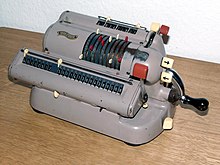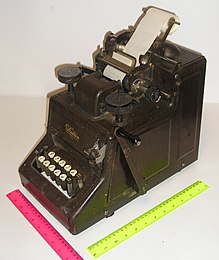The first half of the 20th century saw the gradual development of the mechanical calculator mechanism.
The Dalton adding-listing machine introduced in 1902 was the first of its type to use only ten keys, and became the first of many different models of "10-key add-listers" manufactured by many companies.

In 1948 the miniature Curta calculator, which was held in one hand for operation, was introduced after being developed by Curt Herzstark in 1938. This was an extreme development of the stepped-gear calculating mechanism.
From the early 1900s through the 1960s, mechanical calculators dominated the desktop computing market (see History of computing hardware). Major suppliers in the USA included Friden, Monroe, and SCM/Marchant. (Some comments about European calculators follow below.) These devices were motor-driven, and had movable carriages where results of calculations were displayed by dials. Nearly all keyboards were full — each digit that could be entered had its own column of nine keys, 1..9, plus a column-clear key, permitting entry of several digits at once. (See the illustration of a 1914 mechanical calculator.) One could call this parallel entry, by way of contrast with ten-key serial entry that was commonplace in mechanical adding machines, and is now universal in electronic calculators. (Nearly all Friden calculators had a ten-key auxiliary keyboard for entering the multiplier when doing multiplication.) Full keyboards generally had ten columns, although some lower-cost machines had eight. Most machines made by the three companies mentioned did not print their results, although other companies, such as Olivetti, did make printing calculators.
In these machines, addition and subtraction were performed in a single operation, as on a conventional adding machine, but multiplication and division were accomplished by repeated mechanical additions and subtractions. Friden made a calculator that also provided square roots, basically by doing division, but with added mechanism that automatically incremented the number in the keyboard in a systematic fashion. Friden and Marchant (Model SKA) made calculators with square root. Handheld mechanical calculators such as the 1948 Curta continued to be used until they were displaced by electronic calculators in the 1970s.
 |  |  |
Typical European four-operations machines use the Odhner mechanism, or variations of it. This kind of machines included the Original Odhner, Brunsviga and several following imitators, starting from Triumphator, Thales, Walther, Facit up to Toshiba. Although most of these was operated by handcranks, there were motor-driven versions.
Although Dalton introduced in 1902 first ten-keys printing adding(two operations) machine, these features was not present in computing (four operations) machines for many decades. Facit-T (1932) was the first 10-keys computing machine having a large commercial diffusion. Olivetti Divisumma-14 (1948) was the first computing machine with both printer and 10-keys keyboard. Full-keyboard machines, including motor-driven ones, were also built until 60ties. Some machines had as many as 20 columns in their full keyboards. The monster in this field was the Duodecillion made by Burroughs for exhibit purposes.
 |  |  |  |



0 comments:
Post a Comment